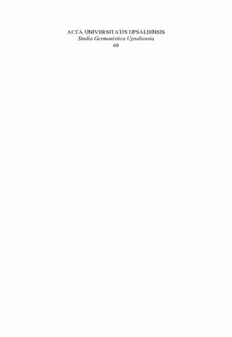
Substantivkomposita und Sinngebung im Kontext frühmittelalterlicher Wissensvermittlung: Eine kulturanalytisch-linguistische Untersuchung zur Wortbildung bei Notker III PDF
Preview Substantivkomposita und Sinngebung im Kontext frühmittelalterlicher Wissensvermittlung: Eine kulturanalytisch-linguistische Untersuchung zur Wortbildung bei Notker III
ACTA UNIVERSITATIS UPSALIENSIS Studia Germanistica Upsaliensia 60 Substantivkomposita und Sinngebung im Kontext frühmittelalterlicher Wissensvermittlung Eine kulturanalytisch-linguistische Untersuchung zur Wortbildung bei Notker III. Nicolaus Janos Raag Dissertation presented at Uppsala University to be publicly examined in Ihresalen, Engelska parken, Humanistiskt centrum, Thunbergsvägen 3L, Uppsala, Saturday, 17 September 2016 at 10:00 for the degree of Doctor of Philosophy. The examination will be conducted in German. Faculty examiner: Prof. Dr. Elvira Glaser (Universität Zürich, Deutsches Seminar). Abstract Raag, N. J. 2016. Substantivkomposita und Sinngebung im Kontext frühmittelalterlicher Wissensvermittlung. Eine kulturanalytisch-linguistische Untersuchung zur Wortbildung bei Notker III. Studia Germanistica Upsaliensia 60. 229 pp. Uppsala: Acta Universitatis Upsaliensis. ISBN 978-91-554-9614-2. This thesis approaches the question of how nominal compounds as linguistic means contribute to the construction of cultural meaning within the framework of knowledge transfer in the medieval monastic school. The starting point for the study is the semiotic definition of culture, which sees culture as shared models for perceiving, relating and interpreting among members of a social group. Language is seen as the place where cultural meaning is constructed and manifests itself in significant patterns, i.e., patterns of language usage that have meaning due to the fact that they are patterns. The central objective of this study is to reveal such patterns in nominal compounds drawn from Old High German (or rather bilingual hybrid) adaptations of Latin school texts translated, or adapted by Notker III (Labeo). Focus is placed on newly formed compounds, as well as compounds that differ distinctively from their Latin models. Methodologically this study combines the morphosemantic analysis of nominal compounds with a hermeneutic approach interpreting compounds in their textual and cultural context. Three significant patterns were established: (1) explication of implied meaning, (2) summary of complex expressions, and (3) explanatory translation. The first pattern can be observed in cases where the power of compounds to give additional information was utilised, e.g., in order to ensure a certain interpretation of a metaphorical expression. The second pattern demonstrates the capacity of compounds to refer to more complex concepts, expressing underlying syntactic constructions in a more memorisable manner. Finally, recourse was taken to explanatory translation in order to make the concept easier to understand. The three patterns are not necessarily the only patterns used by Notker III (Labeo); rather they are to be seen as an exemplification of the potential of nominal compounds for meaning construction. Keywords: word formation, nominal compounds, Cultural Linguistics, knowledge transfer, translation, medieval studies, monastic culture, Notker III of St Gall, Old High German Nicolaus Janos Raag, Department of Modern Languages, German, Box 636, Uppsala University, SE-75126 Uppsala, Sweden. © Nicolaus Janos Raag 2016 ISSN 0585-5160 ISBN 978-91-554-9614-2 urn:nbn:se:uu:diva-297081 (http://urn.kb.se/resolve?urn=urn:nbn:se:uu:diva-297081) Inhaltsverzeichnis 1 Einleitung 13 ................................................................................................... 1.1 Fragestellung 15 .................................................................................. 1.2 BildungundWissensvermittlungimFrühmittelalter 16 .................. 1.2.1 KlosterundKlosterschulealsBildungsträger 17 ................ 1.2.2 NotkerIII.vonSt.GallenalsRepräsentant klösterlicherBildung 25 ....................................................... 1.3 KompositionalsgrundlegendesVerfahrenzum Wortschatzausbau 27 ........................................................................... 1.3.1 AllgemeineDefinitionundEigenschaftenvon Substantivkomposita 28 ........................................................ 1.3.2 SubstantivkompositaimAlthochdeutschen 34 ................... 2 TheoretischerRahmen 45 ............................................................................... 2.1 Sprache,WissenundKultur 45 .......................................................... 2.1.1 KulturtransferundWissensvermittlung 45 ......................... 2.1.2 KulturelleSinngebungdurchsignifikanteMusterinder Sprache 55 ............................................................................. 2.1.3 Kommunikationssituation 58 ............................................... 2.2 KulturanalytischeAnsätzeinderKompositionsforschung 63 .......... 2.3 SubstantivkompositaunterdemAspektderkulturellen Sinngebung 68 ..................................................................................... 3 MaterialundTypisierung 72 .......................................................................... 3.1 Materialgrundlage:NotkersÜbersetzungenkanonischer Schulschriften 72 ................................................................................. 3.1.1 KurzpräsentationderEinzelwerkeimNotker-Korpus 79 .. 3.1.2 ZumProblemderTextauswahlundEinheitlichkeitdes Notker-Korpus 90 ................................................................. 3.2 Materialerhebung 92 ........................................................................... 3.3 IdentifizierungvonSubstantivkompositainNotkersTexten 93 ....... 3.3.1 KriterienzurBestimmungvonalthochdeutschen Substantivkomposita 96 ........................................................ 3.3.2 GrenzfällederKomposition 104 .......................................... 3.4 Neubildungen:NeologismenundAd-hoc-Bildungen 109 ................ 3.4.1 DefinitionvonNeubildungen 109 ........................................ 3.4.2 AbgrenzungderNeubildungenimNotker-Korpus 110 ..... 3.5 SubstantivkompositaimVerhältniszuihrerlateinischen Vorlage 112 .......................................................................................... 3.5.1 Lehngutforschung 113 .......................................................... 3.5.2 TypologiedesVerhältnissesvonKompositazuihrer lateinischenÜbersetzungsvorlage 120 ................................ 3.6 Exkurs:ZurFragedesLexemstatusalthochdeutscher Bildungen 126 ...................................................................................... 4 MethodischeAnsätze 133 .............................................................................. 4.1 MethodenderhistorischenSemantik 134 .......................................... 4.2 VerortunginKotextundKontext 137 ................................................ 5 SignifikanteMusterderSinngebung 139 ...................................................... 5.1 SinngebungdurchExplikationvonInhalten 140 .............................. 5.1.1 Metaphern 142 ...................................................................... 5.1.2 Wertungen 145 ...................................................................... 5.2 SinngebungdurchZusammenfassungkomplexerInhalte 164 ......... 5.3 SinngebungdurcherklärendeÜbersetzung 169 ................................ 5.3.1 LateinischeFachbegriffe 169 ............................................... 5.3.2 Griechisch-römischeGötternamen 177 ............................... 6 SinngebungmitanderenWortbildungsmodellen 196 .................................. 7 ZusammenfassungundAusblick 200 ............................................................ VerzeichnisderimTextgenanntenundbehandeltenKomposita 205 ............... Literatur 211 .......................................................................................................... Tabellenverzeichnis Tabelle3.1: DieWerkeNotkersIII. 74 ................................................................ Tabelle3.3: VerhältnisderKompositazuihrerÜbersetzungsvorlage 122 ....... Abbildungsverzeichnis Abbildung1.1: BildhafteDarstellungdesQuadriviums 19 ............................... Abbildung1.2: MittelalterlicheUnterrichtssituation 23 .................................... Abbildung1.3: Magister-cum-discipulis-Darstellung 24 ................................... Abbildung1.4: EintragNotkersimSt.GallerNekrolog 26 ............................... Abbildung3.1: AnfangvonNotkersConsolatio-Bearbeitung 82 ..................... Abbildung3.2: AnfangvonNotkers„MartianusCapella“-Bearbeitung 83 ..... Abbildung3.3: LogischesQuadratinDeinterpretatione 84 ............................. Abbildung3.4: ‚Titelseite‘vonNotkersPsalter-Bearbeitung 85 ....................... Abbildung3.5: GliederungdesLehngutsnachBetz(1974) 114 ...................... Abbildung3.6: GliederungvonEntlehnungennachHaugen(1972) 119 ......... Abbildung5.1: Seite34derPsalter-HandschriftmitBeispiel(1) 141 ............. Abbildung5.2: Beginnder„kleinenRhetorik“mitBeispiel(10a) 171 ............ Abbildung5.3: IllustrationderkontinuierlichenQuantitativen 174 .................. Abkürzungen ahd. althochdeutsch Akk. Akkusativ Anm. Anmerkung(Fußnotebzw.Endnote) Art. Lexikon-/Wörterbuchartikel as. altsächsisch Bd. Band c. canticum: Gedicht in der Consolatio Philosophiae des Boe- thius, bei Verweisen auf Textstücke der Form: (Buch) I, c.1, (Zeile)1. Cgm Codexgermanicusmonacensis,deutschsprachigeHandschrift derBayerischenStaatsbibliothekMünchen Cod. Codex(Handschrift) Cod.Sang. Codex Sangallensis, Handschrift der Stiftsbibliothek St. Gal- len(CESG:Digitalisate:) Dat. Dativ engl. englisch frnhd. frühneuhochdeutsch frz. französisch frÜ. freieÜbersetzung(s.Seite124) Gen. Genitiv Ggü. Glied-für-Glied-Übersetzung(s.Seite121) gr. (alt-)griechisch lat. lateinisch Lbed. Lehnbedeutung Lsch. Lehnschöpfung Lüs. Lehnübersetzung Lüt. Lehnübertragung M. Maskulinum Mk. Mischkompositum(s.Seite124) mlat. mittellateinisch Mos (biblisches)BuchMose Ms. Manuskript(Handschrift) Mt Matthäus(evangelium) N. Neutrum Nom. Nominativ NP,NPs Nominalphrase,Nominalphrasen obd. oberdeutsch Part. Partizip Pl. Plural pr. prosa:ProsastückinderConsolatioPhilosophiaedesBoethi- us,beiVerweisenaufTextstückederForm:(Buch)I,pr.1. Prät. Präteritum Ps Psalm(WerdenzweiPsalmennummernangegeben,sobezieht sich die erste (höhere) auf die Zählung nach dem masoreti- schenText,diezweiteinKlammerngeschriebeneaufdieZäh- lungnachderSeptuaginta,derauchdieVulgatafolgt.) S. Seite s. siehe schwed. schwedisch Sg. Singular Sp. Spalte VP Verbalphrase Weish (biblisches)BuchderWeisheit Zusb. Zusammenbildung Übt. Übertragung(s.Seite121) Üs. Übersetzung(von) → Wortbildungsbedeutung
